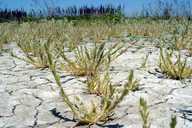Taxon Report
Orcuttia pilosa Hoov.hairy Orcutt grass |
 © 2003 George W. Hartwell |
Taxon Summary
Orcuttia pilosa, commonly known as hairy Orcutt grass, is a annual herb in the Poaceae that is found only in California. It occurs within Vernal pools, growing at elevations from 46 to 200 meters. Orcuttia pilosa is ranked 1B.1, Plants Rare, Threatened or Endangered in California and Elsewhere; Seriously threatened in California.Classification
|
Scientific Name: |
Orcuttia pilosa Hoov. |
|
Common Name: |
hairy Orcutt grass |
| Family: | Poaceae |
| Element Code: | PMPOA4G040 |
| USDA Plants Symbol: | ORPI |
|
Synonyms/Other Names: |
|
Ecology and Life History
| Lifeform: | annual herb |
| Blooming Period: May-Sep | May-Sep |
| Elevation: | 46-200 (150-655) |
| General Habitats: | Vernal pools |
| Microhabitat: | |
| Microhabitat Details: |
Conservation Status
| CA Rare Plant Rank: | 1B.1 |
| Global Rank: | G1 |
|
State Rank: |
S1 |
| State List: | CE |
| Fed List: | FE |
| Other Status: | SB_CalBG/RSABG |
|
CRPR Changes: |
|
Occurrence Data from the CNDDB
| Total Occurrences: | 35 |
| Element Occurrence Ranks: | |
| Excellent (A) | 3 |
| Good (B) | 8 |
| Fair (C) | 4 |
| Poor (D) | 3 |
| None (X) | 15 |
| Unknown (U) | 2 |
| California Endemic: True | |
| California Counties and Islands: Name (Code) | |
| Glenn (GLE), Madera (MAD), Merced (MER), Stanislaus (STA), Tehama (TEH) | |
| Quads: Name (Quad Code) | |
| Cooperstown (3712065)*, Daulton (3711918), Gregg (3611988), Herndon (3611978), Kismet (3712011)*, Lanes Bridge (3611987), Logandale (3912242), Madera (3612081), Merced (3712034), Montpelier (3712056), Paulsell (3712066)*, Richardson Springs NW (3912188), Turlock Lake (3712055), Vina (3912281), Yosemite Lake (3712044)* | |
Threat List Data from the CNDDB
| Threat List Total: | 11 | |
| EOs with Threat Listed: | Total EOs | % of EOs |
| 30 | 86 % | |
| Agriculture | 17 | 48% |
| Grazing | 17 | 48% |
| Non-native plant impacts | 9 | 25% |
| Disking | 7 | 20% |
| Altered flood/tidal/hydrologic regime | 4 | 11% |
| Development | 4 | 11% |
| Foot traffic/trampling | 3 | 8% |
| Road/trail construction/maint. | 2 | 5% |
| Erosion/runoff | 1 | 2% |
| ORV activity | 1 | 2% |
| Other | 1 | 2% |
Citation
California Native Plant Society, Rare Plant Program. 2025. Rare Plant Inventory (online edition, v9.5.1). Website https://www.rareplants.cnps.org [accessed 23 December 2025].